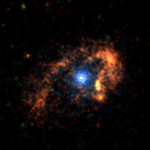CXC Home | Search | Help | Image Use Policy | Latest Images | Privacy | Accessibility | Glossary | Q&A
Q&A: Normal Stars, White Dwarf Stars, and Star
Clusters
Q:
Do you have a list of the biggest stars?
A:
The adjective "biggest" covers a multitude of sins, when
referring to stars. The biggest stars in both size and mass
are ones that are producing so much radiation that they are
barely able to hold together. Their intense radiation fields
are driving mass off the star at such a high rate that it is
difficult to tell just how large the star really is. What
astronomers can measure is how much energy the star is
producing. They can fold this information into theoretical
models to get an estimate of the mass of the star. Using this
method, the title of heavyweight champion goes to the Pistol
star in the constellation Sagittarius, near the center of our
Milky Way Galaxy. The Pistol Star shines with the power of 10
million suns, and has a mass estimated to lie between 150 and
200 suns.
Some stars in the Galaxy and the Magellanic Clouds (satellite
galaxies of the Milky Way) are almost as powerful. Mk 42 and
Sk-67 211 in the Large Magellanic Cloud are of similar
luminosity. Eta Carinae in our galaxy and HD 5980 in the
Small Magellanic Cloud have the luminosities of several
million suns, but they are apparently double stars. AG
Carinae and R127 both top a million solar luminosities, and
may brighten to equal the Pistol Star from time to time.
All these stars are losing mass so rapidly that, if they
continued at their present rate for ten million years, they
would be a mere shadow of their former brilliance. Before
that happens, however, they will end their life as a
supernova, and in all likelihood leave behind a black
hole.



